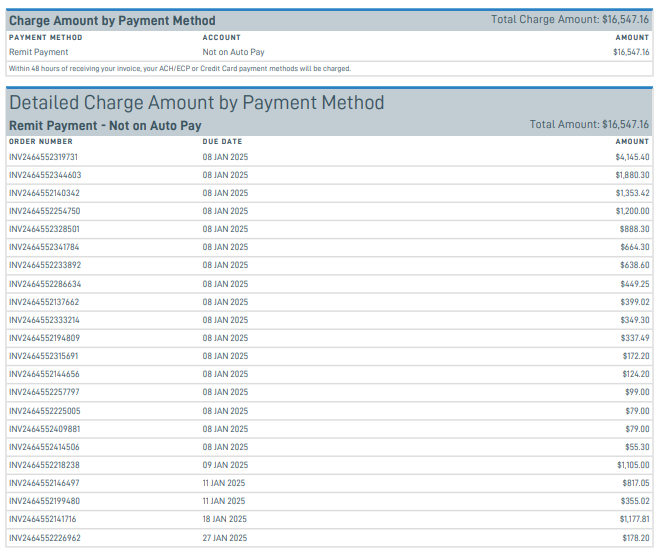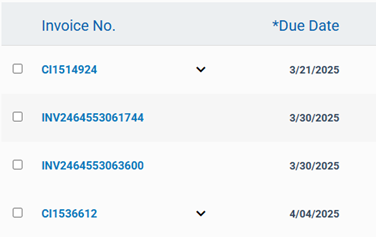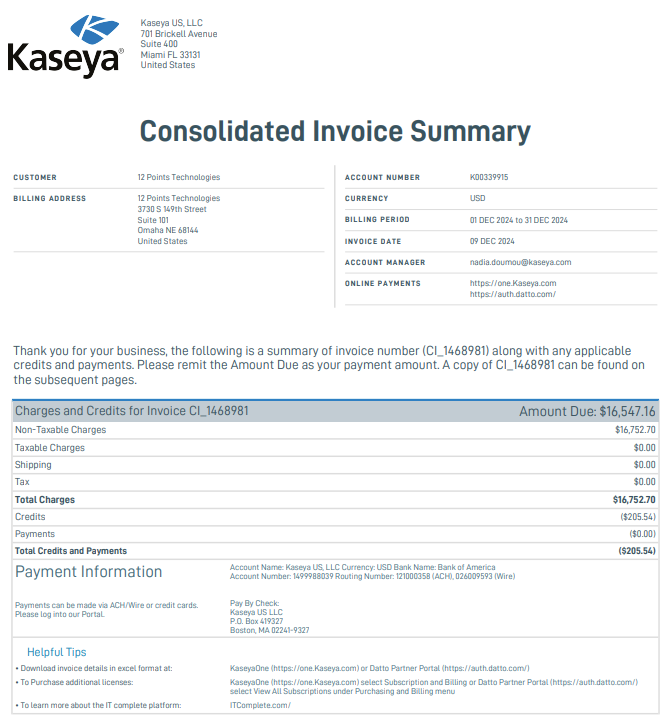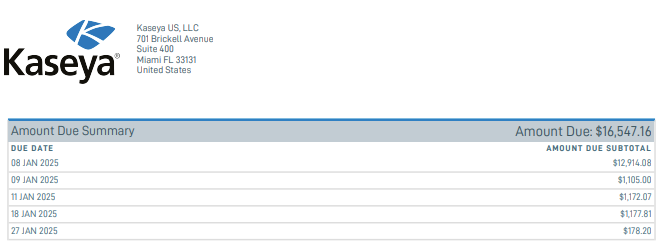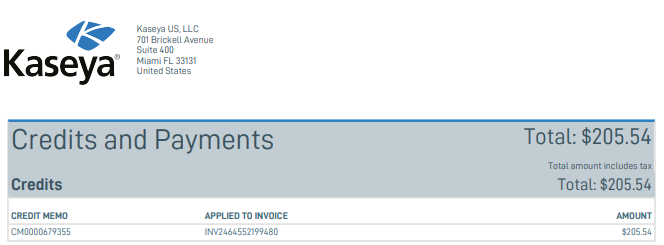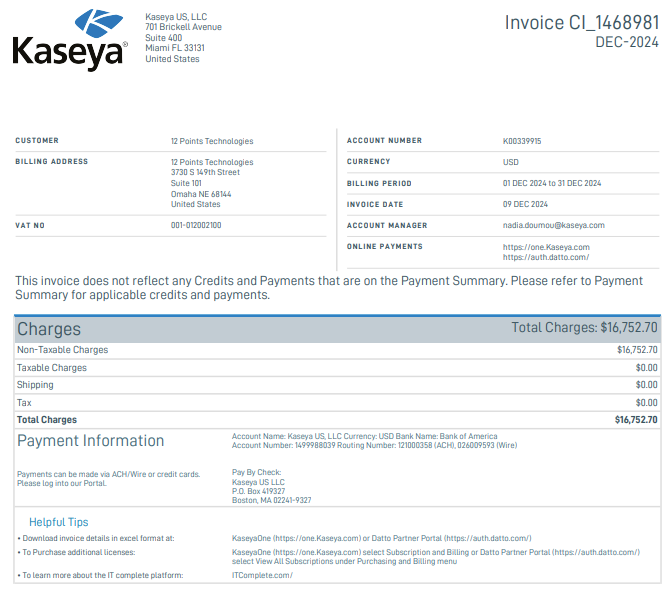Understanding your invoice
NAVIGATION Home > Subscriptions & Billing > View and Pay Invoices
PERMISSIONS Master or Billing role
This article will go over the different types of invoices, as well as how to read an invoice to help you understand the information that is presented there.
You will see two types of invoices in the Billing portal - individual and consolidated:
-
Individual invoices have the letters INV at the beginning of the invoice number.
-
Consolidated invoices have the letters CI at the beginning of the invoice number.
Individual invoices
Customers will receive an individual invoice when they make a new purchase during the month. This invoice will typically cover the one-time portion of the purchase that is due up front. Examples of what's covered in a standalone individual invoice include hardware items, onboarding fees, and any proration for the first month for the subscriptions that were purchased. In certain unique cases, individual invoices can be sent out in order to “true up” billing from previous months or address open issues with an account. This is less common.
Consolidated invoices
A consolidated invoice aggregates all of the children invoices that cover the reoccurring fees for the subscriptions a customer has in a given month. Consolidated invoices are sent out once a month, typically at the beginning of the month.
You can expand or collapse a consolidated invoice to see the children invoices by clicking on the arrow next to the invoice number.
NOTE Keep in mind that the due date you see next to a consolidated invoice reflects the earliest of the due dates for the children invoices under that consolidated invoice.
Your consolidated invoice is made up of five key sections:
-
Consolidated invoice summary
-
Credits and payments
-
Charges
-
Details per organization or client
-
Charge amount by payment method
This is where you'll find your amount due for this billing period. The amount due reflects the charges you’ve incurred during this period minus any credits or payments that were applied to any of the children invoices that make up the consolidated invoice.
Next in the summary section, you will also find a breakdown of the amount due by the individual due dates. As mentioned earlier, it is possible for some of the children invoices that are part of a consolidated invoice to have different due dates.
The next section of the consolidated invoice shows any credits and payments that were applied to this invoice. You'll see the specific child invoice number that a credit was applied to. It is important to remember that this section does not show all credits and payments on the account. It only shows the ones that were applied to pay some of the children invoices that are part of this specific consolidated invoice. To view a list of all your credits and payments, please visit the transaction history section of the billing portal.
The Charges page looks very similar to the first page of the consolidated invoice. These two pages contain a lot of the same information, but the Charges page does not show any credits or payments that have been applied. It only shows the charges incurred for the period.
Summary Charges by Category
The Charges section includes the Summary Charges by Category that shows you how your total spend is spread out across each category of services that you purchased.
EXAMPLE As an example, for this invoice, you'll see that $1,250 of the total spend is for RMM.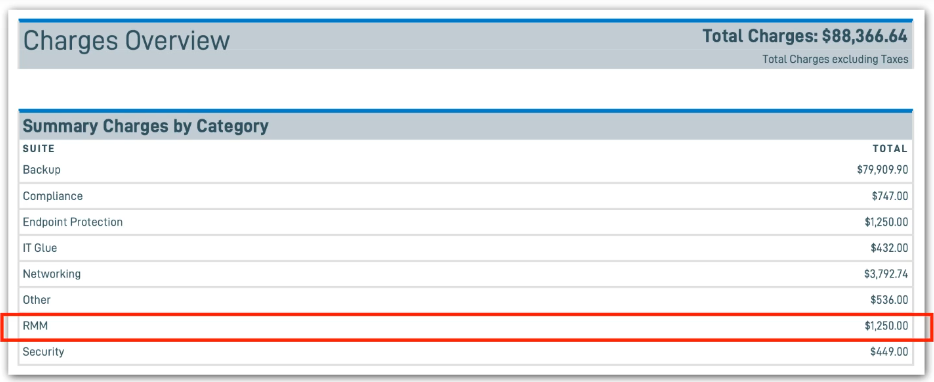
In addition to the summary by category, you will also see a breakdown of your spend within each category.
EXAMPLE Taking the earlier RMM example, you’ll see that the $1,250 being billed in this period is a result of 2 orders that were placed over time for a combined quantity of 1,250 licenses at $1 each.
It's important to note that the amounts in the charges by category section are what go into your total charges for this billing period. This is what makes up your invoice amount.
The details per organization, or client, section is informational only and not part of your invoice. It is intended to help you understand how what you bought from us is being consumed by your end clients. While we do show pricing in this section, it is intended to help you allocate your cost to your end clients. The totals in this section do not go into your amount due. As stated earlier, your total charges, and what we bill you for, is driven by the amounts in the charges by category section only.
In the details per organization section, we will list your end clients along with the services that they are using. In this example, this end client has 30 licenses of SaaS protection as well as one networking service. We've allocated the cost of those services to this client for your information only. Keep in mind that this section only shows the end client usage information for services that have this capability.
EXAMPLE For example, if you purchased IT Glue licenses from us, you’ll see that in the charges by category section. That cost would not be in the details by client section, since there is no end client information tied to those IT Glue licenses that you are using. Another example could be that you purchased 100 licenses of SaaS Protection from us, but are only using 80 of them for your end clients. In this case, you would see the charge for the 100 licenses from us, but only 80 of them allocated in the details per organization section.
In the last section of the invoice, you will see what payment methods are associated with your total amount due.
EXAMPLE In this example, you’ll see that the customer has a portion of their invoice tied to their AMEX card for automatic payment, while the remaining balance is not on autopay. You can also find the specific list of children invoices and their due dates under each payment method. Any invoices not on autopay can be paid via the portal or through the banking information listed on the first page of the invoice.